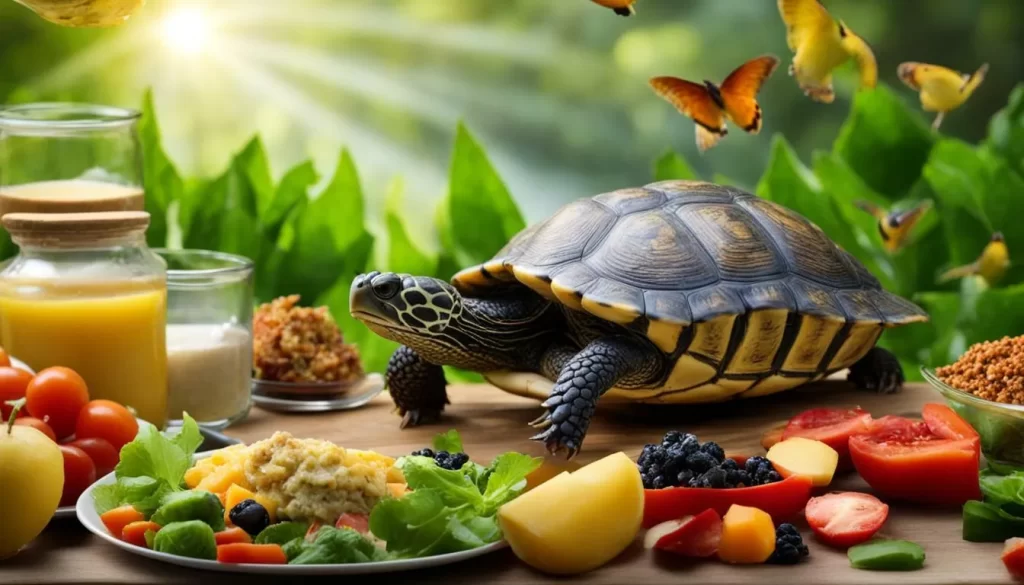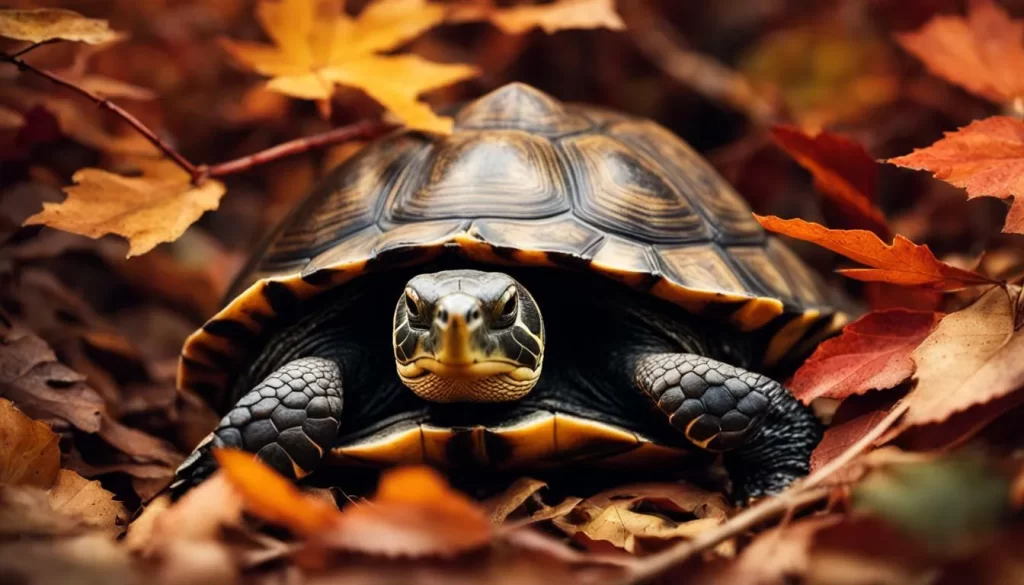Feeding pet turtles is an essential aspect of their care, and establishing a proper feeding routine is crucial for their health and wellbeing.
When it comes to feeding your pet turtle, several factors should be considered, including their age, species, and individual appetite.
For juvenile turtles, it is recommended to feed them every day and provide vitamin and calcium supplements about three times a week.
As turtles mature, their feeding frequency decreases, typically to every other day or even every third day for adult turtles.
To maintain a clean and healthy habitat, it’s important to remove any uneaten food from the turtle’s enclosure after 20 minutes.
This helps prevent decay and ensures a hygienic environment for your pet.
A balanced diet is essential for the overall health of your pet turtle. They should be given a variety of foods in their diet, including high-quality turtle food, live food such as worms and crickets, leafy greens, fruits, and vegetables.
It’s important to mimic their natural diet and provide the recommended portions of each food group.
Overfeeding can have negative consequences for pet turtles, including obesity, shell pyramiding, and metabolic bone disease.
Following the feeding guidelines and consulting a veterinarian or turtle specialist for guidance is essential to avoid these health issues.
Key Takeaways:
- Feeding pet turtles regularly is crucial for their health and wellbeing.
- Juvenile turtles should be fed every day and given vitamin and calcium supplements.
- As turtles mature, their feeding frequency decreases.
- Removing uneaten food from the habitat prevents decay and maintains a clean environment.
- A balanced diet for pet turtles includes high-quality turtle food, live food, leafy greens, fruits, and vegetables.
- Mimicking a turtle’s natural diet is important for their overall health.
- Overfeeding can lead to obesity, shell pyramiding, and metabolic bone disease.
Factors to Consider for Feeding Pet Turtles
Several factors should be taken into account when determining the appropriate feeding frequency for your pet turtle.
These factors include the age of your turtle, its species, and its individual appetite. Understanding these factors will help you create a feeding schedule that promotes the health and well-being of your pet.
When it comes to feeding juvenile turtles, a higher feeding frequency is necessary as they are growing and developing quickly.
It is recommended to feed juvenile turtles every day and provide them with vitamin and calcium supplements about three times a week.
These supplements are essential for their bone health and overall nutrition.
As turtles mature and reach adulthood, their metabolic rate slows down, and they require less frequent feedings.
Adult turtles typically need to be fed every other day or even every third day. This decrease in feeding frequency ensures that your turtle maintains a healthy weight and avoids potential health issues associated with overfeeding.
In addition to feeding frequency, it is important to remove any uneaten food from your turtle’s habitat after approximately 20 minutes.
This prevents the food from decaying and creating a dirty or unhealthy environment for your pet. Regular cleaning and maintaining a clean habitat are vital for the overall well-being of your pet turtle.
| Feeding Frequency | Juvenile Turtles | Adult Turtles |
|---|---|---|
| Recommended Schedule | Every day | Every other day or every third day |
| Vitamin and Calcium Supplements | 3 times a week | 3 times a week |
When it comes to the diet of your pet turtle, it’s important to provide a balanced and varied selection of foods.
This includes high-quality turtle food, live food such as worms and crickets, leafy greens, fruits, and vegetables.
By mimicking their natural diet, you can ensure that your turtle receives the necessary nutrients for optimal health.
It’s crucial to follow the recommended portions of each food group to prevent overfeeding and maintain a healthy weight.
Remember that overfeeding can lead to obesity, shell pyramiding, and metabolic bone disease in turtles.
It’s important to carefully follow feeding guidelines and consult with a veterinarian or turtle specialist for guidance.
They can provide valuable advice tailored to your pet turtle’s specific needs and help you establish a suitable feeding routine that promotes their overall health and longevity.
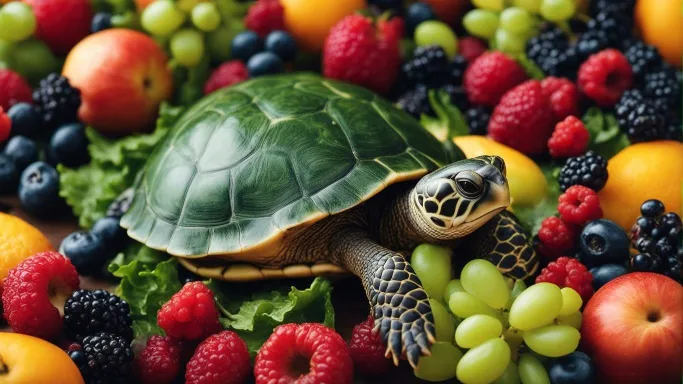
Feeding Recommendations for Juvenile Turtles
Juvenile turtles have different dietary needs compared to adult turtles, and they require more frequent feedings to support their growth and development.
It is recommended to feed them every day to ensure they receive adequate nutrition. Additionally, providing vitamin and calcium supplements about three times a week is crucial for their healthy development.
When it comes to feeding juvenile turtles, it is important to offer a varied diet that includes both commercial turtle food and live food.
High-quality turtle food pellets should make up a significant portion of their diet, as these contain essential nutrients.
However, it is important to supplement their diet with live food, such as worms and crickets, which mimic their natural foraging behavior and provide additional nutritional value.
| Food Group | Recommended Frequency |
|---|---|
| Commercial Turtle Food | Every day |
| Live Food (worms, crickets) | 2-3 times a week |
| Leafy Greens | Every day |
| Fruits | 2-3 times a week |
| Vegetables | 2-3 times a week |
Leafy greens, fruits, and vegetables should also be included in their diet. These provide essential vitamins and minerals that support their overall health and well-being. Offering a variety of leafy greens, like kale and spinach, along with fruits and vegetables, such as berries and carrots, ensures a balanced and nutritious diet for your juvenile turtle.
Remember to monitor your turtle’s appetite and adjust the portion sizes accordingly. Do not overfeed, as this can lead to health issues. It is important to follow these feeding recommendations and consult with a veterinarian or turtle specialist for personalized guidance to ensure your juvenile turtle receives optimal nutrition for their development.
Feeding Recommendations for Adult Turtles
As turtles mature, their feeding requirements change, and it’s important to adjust their feeding schedule accordingly to maintain their health. Adult turtles typically require less frequent feedings compared to their juvenile counterparts. Feeding adult turtles every other day or even every third day is generally sufficient to meet their nutritional needs. It’s important to note that some turtles may have individual preferences or dietary restrictions, so it’s always a good idea to consult a veterinarian or turtle specialist for specific feeding guidelines for your turtle species.
When it comes to providing a balanced diet for adult turtles, variety is key. A well-rounded diet should include a combination of high-quality turtle food, live food like worms and crickets, leafy greens, fruits, and vegetables. These different food groups provide essential nutrients and help replicate a turtle’s natural diet. You can offer a mixture of commercial turtle pellets and fresh foods to ensure a comprehensive nutritional intake.
Recommended Adult Turtle Feeding Schedule:
| Food Group | Feeding Frequency |
|---|---|
| Commercial turtle pellets | Every other day |
| Live food (worms, crickets) | Once or twice a week |
| Leafy greens | Every other day |
| Fruits and vegetables | Every other day |
It’s important to monitor your turtle’s weight and appearance to ensure they are receiving the right amount of food. Overfeeding can lead to obesity, shell pyramiding, and metabolic bone disease, so it’s crucial to follow feeding guidelines and avoid excessive treats or fatty foods. Remember to remove any uneaten food from the habitat after 20 minutes to maintain a clean and healthy environment for your turtle. By providing a balanced diet and following best practices for feeding, you can help your adult turtle thrive and maintain optimum health.
Removing Uneaten Food to Maintain a Healthy Habitat
After each feeding session, it is crucial to remove any uneaten food from the turtle’s habitat to prevent bacterial growth and maintain a hygienic living space. Leaving uneaten food in the habitat can lead to water contamination and create an unhealthy environment for your pet turtle.
To effectively remove uneaten food, use a fish net or a small sieve to scoop out any leftover food particles. Be thorough and check all areas of the habitat, including the substrate, rocks, and other decorations. Make sure to dispose of the uneaten food properly, as leaving it in the habitat can also attract pests.
In addition to removing uneaten food, it’s important to establish a feeding routine for your pet turtles. Feeding them at the same time and place every day can help them develop a healthy eating habit and make it easier for you to monitor their food intake. This routine also allows you to observe any changes in appetite or behavior, which may signal underlying health issues.
Table: Recommended Feeding Schedule for Pet Turtles
| Turtle Age | Feeding Frequency |
|---|---|
| Juvenile turtles | Every day |
| Adult turtles | Every other day or every third day |
Remember, feeding your pet turtle the right amount of food is just as important as removing any leftovers. Overfeeding can lead to various health problems, so make sure to follow the recommended portion sizes for your turtle’s age and species. Consulting a veterinarian or turtle specialist can provide you with further guidance on feeding your pet turtle and ensuring their nutritional needs are met.
Providing a Balanced Diet for Pet Turtles
Offering a varied and balanced diet is essential for meeting the nutritional needs of pet turtles and promoting their overall health.
Turtles require a combination of commercial turtle food, live food, leafy greens, fruits, and vegetables to ensure they receive all the necessary nutrients for optimal growth and development.
When it comes to commercial turtle food, choose a high-quality brand that is specifically formulated for your turtle’s species.
These pellets or sticks should be the main component of their diet and provide a balanced mix of proteins, fats, and carbohydrates.
Feed your pet turtle the recommended portion size according to their age and size, usually a few pellets or sticks per feeding.
| Food Group | Examples |
|---|---|
| Live Food | Worms, crickets, mealworms |
| Leafy Greens | Kale, dandelion greens, collard greens |
| Fruits | Apples, berries, melons |
| Vegetables | Carrots, squash, bell peppers |
In addition to commercial turtle food, incorporate live food into your turtle’s diet. This can include worms, crickets, or mealworms, which provide essential protein.
These live prey stimulate their natural hunting instincts and provide mental stimulation.
Leafy greens, such as kale, dandelion greens, and collard greens, should also be a staple in your pet turtle’s diet.
They are rich in vitamins and minerals and help maintain proper digestion. Fruits, like apples, berries, and melons, can be offered as occasional treats, while vegetables such as carrots, squash, and bell peppers add additional variety and nutrition to their diet.
Portion Guide
- Commercial turtle food: Follow the manufacturer’s recommendations for portion size based on your turtle’s age and size.
- Live food: Offer a few live prey items per feeding, adjusting the quantity as needed to maintain a healthy weight.
- Leafy greens: Offer a small handful of leafy greens daily.
- Fruits and vegetables: Provide a small portion of fruits or vegetables a few times a week.
Remember, overfeeding can lead to health issues like obesity, shell pyramiding, and metabolic bone disease, so it’s crucial to follow these feeding recommendations and consult a veterinarian or turtle specialist for personalized guidance on your pet turtle’s diet.
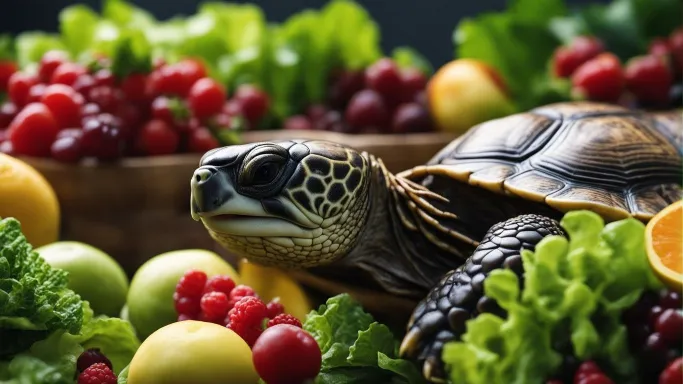
Mimicking a Turtle’s Natural Diet
Replicating a turtle’s natural diet is crucial for their overall health and wellbeing, and it involves selecting food items that closely resemble what they would consume in the wild.
Turtles are omnivorous creatures, meaning they eat a variety of plant and animal matter to meet their nutritional needs.
By providing a balanced and diverse diet, you can ensure that your pet turtle receives all the essential nutrients they require.
To create a diet that mimics a turtle’s natural feeding habits, consider the following:
- High-Quality Turtle Food: Start with a base of high-quality commercial turtle food that is specifically formulated for your turtle’s species. Look for options that contain a variety of ingredients, including proteins, vitamins, and minerals.
- Live Food: Supplement the diet with live food, such as worms, crickets, or small fish. These live prey items provide essential proteins and stimulate your turtle’s hunting instincts. Be sure to purchase live food from reputable sources to avoid introducing any parasites or diseases.
- Leafy Greens: Include a variety of leafy greens in your turtle’s diet, such as kale, collard greens, or dandelion greens. These provide important vitamins and minerals, as well as fiber to aid in digestion.
- Fruits and Vegetables: Offer a selection of fruits and vegetables to provide additional nutrients and variety. Examples include carrots, bell peppers, apples, and berries. Remember to remove any uneaten portions after feeding to prevent spoilage.
When feeding your turtle, it’s important to provide appropriate portions based on their size and age. Younger turtles generally require more frequent feedings, while adult turtles can be fed every other day or even every third day. It’s essential to monitor your turtle’s weight and adjust their diet accordingly to prevent overfeeding and associated health issues. Always consult a veterinarian or turtle specialist for specific feeding guidelines based on your turtle’s species and individual needs.
| Food | Frequency | Portion Size |
|---|---|---|
| High-Quality Turtle Food | Every day | As recommended on the packaging |
| Live Food | 2-3 times a week | A portion that can be consumed within 10-15 minutes |
| Leafy Greens | Every day | A few leaves |
| Fruits and Vegetables | Every other day | Small amounts, approximately the size of their head |
Potential Health Issues from Overfeeding
Overfeeding pet turtles can have detrimental effects on their health, and it is important to follow feeding guidelines to prevent potential complications. Turtles have a slow metabolism, and their bodies are not designed to handle excessive amounts of food. When turtles consume more food than they can metabolize, it can lead to obesity, shell pyramiding, and metabolic bone disease.
Obesity is a common problem in pet turtles, especially when they are overfed or given an imbalanced diet. This can put a strain on their organs and joints, leading to reduced mobility and overall health issues. Additionally, an overweight turtle may have difficulty retracting its head and limbs into its shell for protection.
Shell pyramiding is a condition where the scutes on a turtle’s shell start to grow upward, giving the shell a pyramid-like appearance. This condition is often caused by overfeeding and a lack of proper nutrition. It can weaken the shell and make it more susceptible to injury and infection.
Metabolic bone disease is a serious condition that occurs when a turtle’s body does not receive enough calcium and vitamin D3. This can lead to softening of the bones, shell deformities, and even fractures. Overfeeding can contribute to metabolic bone disease as it may disrupt the balance of nutrients in the turtle’s diet.
| Health Issues from Overfeeding | Potential Complications |
|---|---|
| Obesity | Reduced mobility, organ strain |
| Shell Pyramiding | Weakened shell, susceptibility to injury and infection |
| Metabolic Bone Disease | Softening of bones, shell deformities, fractures |
To prevent these health issues, it is crucial to feed your pet turtle according to their specific needs and follow a balanced diet. Consult a veterinarian or turtle specialist for guidance on feeding guidelines and portion sizes. By providing your turtle with the right amount of food and nutrients, you can help them maintain a healthy weight and minimize the risk of these potential complications.
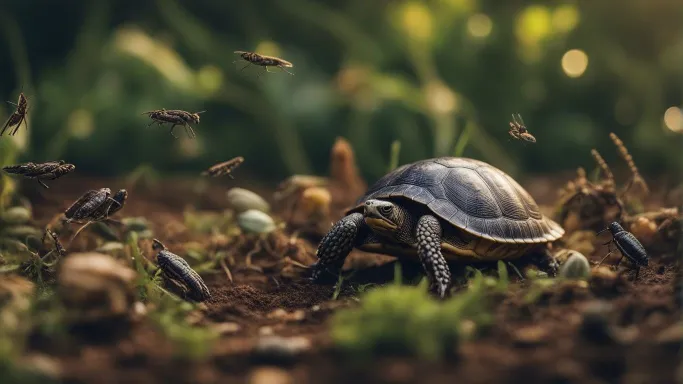
Consulting Experts for Feeding Guidance
If you have any concerns or questions about feeding your pet turtle, it is advisable to seek advice from a qualified professional to ensure their optimal care. Experts, such as veterinarians or turtle specialists, have the knowledge and experience to provide you with specific guidance tailored to your turtle’s needs. They can help you determine the appropriate feeding frequency, portion sizes, and the right balance of nutrients for your pet.
Consulting experts is particularly important when it comes to feeding juvenile turtles, as their nutritional requirements may differ from those of adult turtles. These specialists can guide you in establishing a feeding routine that promotes healthy growth and development, ensuring that your juvenile turtle receives the necessary vitamins and minerals for their overall well-being.
In addition to providing feeding recommendations, experts can also address any health issues or concerns related to your pet turtle’s diet. They can help you identify and resolve problems such as obesity, shell abnormalities, or imbalances in their diet. By seeking professional guidance, you can ensure that your pet turtle remains in good health and receives the best care possible.
| Benefits of Consulting Experts for Feeding Guidance |
|---|
| 1. Tailored advice based on your turtle’s specific needs |
| 2. Expert knowledge on feeding frequency and portion sizes |
| 3. Guidance on providing a balanced and nutritious diet |
| 4. Identification and resolution of health issues related to diet |
Final Thoughts
In conclusion, understanding how often to feed your pet turtle and providing them with a balanced diet is essential for their overall health and happiness.
When it comes to feeding pet turtles, there are a few factors to consider, such as age, species, and individual appetite.
It’s important to establish a feeding routine that meets their nutritional needs and supports their growth and development.
For juvenile turtles, daily feedings are typically necessary, with vitamin and calcium supplements given about three times a week.
As turtles mature into adults, they require less frequent feedings, usually every other day or even every third day.
It’s crucial to remove any uneaten food from their habitat after 20 minutes to prevent decay and maintain a clean and healthy environment.
A balanced diet plays a vital role in the well-being of pet turtles. They should be provided with a variety of foods, including high-quality turtle food, live food such as worms and crickets, leafy greens, fruits, and vegetables.
It’s essential to mimic their natural diet and provide the recommended portions of each food group to ensure they receive the necessary nutrients.
However, it’s important to avoid overfeeding as it can lead to health issues such as obesity, shell pyramiding, and metabolic bone disease.
Following feeding guidelines and consulting a veterinarian or turtle specialist for guidance is crucial to ensure your pet turtle’s health and well-being.
Additional Resources for Pet Turtle Care
| Resource | Description |
|---|---|
| Turtle Care Guide | A comprehensive guide to caring for pet turtles, including feeding tips, habitat setup, and health care. |
| Turtle Species Identification | A helpful resource for identifying different turtle species and understanding their specific care requirements. |
| Turtle Nutrition and Diet | An in-depth article on turtle nutrition, discussing the importance of a balanced diet and providing food recommendations for different turtle species. |
By following these feeding tips for pet turtles and providing proper care and nutrition, you can ensure that your pet turtle lives a healthy and fulfilling life.
Additional Resources for Pet Turtle Care
For further information on pet turtle care, including feeding schedules and nutrition, here are some helpful resources to explore:
– “The Complete Turtle Care Guide” by Dr. Emily Brown: This comprehensive guide covers all aspects of turtle care, including feeding guidelines and nutrition requirements. It provides expert advice on creating a balanced diet for your pet turtle.
– “Turtle Feeding 101” video by Turtle World: This informative video explains the importance of proper feeding for pet turtles. It offers practical tips on establishing a feeding routine and selecting the right foods for your turtle.
– “Turtle Care Tips” blog by Turtle Lovers: This blog features a variety of articles on turtle care, including detailed information on feeding schedules and nutritional needs. It offers valuable insights from experienced turtle owners and experts in the field.
– “The Turtle Handbook” by Turtle Society: This handbook is a great resource for both beginners and experienced turtle owners. It includes a section dedicated to feeding guidelines, providing a step-by-step approach to ensure your pet turtle receives the optimal nutrition.
By exploring these resources, you can gain a deeper understanding of pet turtle care, feeding schedules, and nutrition requirements. Remember to consult a veterinarian or turtle specialist for personalized advice tailored to your pet’s specific needs.
Frequently Asked Questions
Q: How much should I feed my turtle a day?
A: The amount of food a turtle requires depends on its species, age, size, and overall health. Generally, a portion size similar to the size of the turtle’s head is a good guideline for pellet food. Consult with a reptile veterinarian or expert for specific recommendations.
Q: Can you overfeed turtles?
A: Yes, turtles can be overfed which can lead to obesity and related health issues. It’s important to monitor their diet and provide appropriate portions.
Q: How long can my pet turtle go without food?
A: Adult turtles can go without food for a few weeks to a month in some cases, but it’s not recommended. Younger turtles require more frequent feeding. Always ensure they receive a balanced diet and fresh water.
Q: How many times do pet turtles eat a day?
A: Most pet turtles are fed once a day, but younger turtles or those with specific dietary needs might be fed twice a day.
Q: How many pellets should I feed my turtle?
A: The number of pellets to feed depends on the size of the pellets and the size of the turtle. As a general rule, offer an amount equivalent to the size of the turtle’s head. It’s important to refer to the feeding guidelines on the pellet package and consult with experts.
Q: How often do baby turtles eat?
A: Baby turtles typically require more frequent feeding, often once or twice a day, to support their rapid growth.
Q: What vegetables do turtles eat?
A: Turtles can eat a variety of leafy greens like kale, dandelion greens, and red leaf lettuce. Some also enjoy vegetables like shredded carrots, bell peppers, and zucchini. The specific vegetables to offer can vary based on the turtle species.
Q: Do turtles eat at night or during the day?
A: Most turtles are diurnal, meaning they are active during the day and will typically eat during daylight hours. However, some species might have different patterns, so it’s always good to observe your turtle’s habits and preferences.


